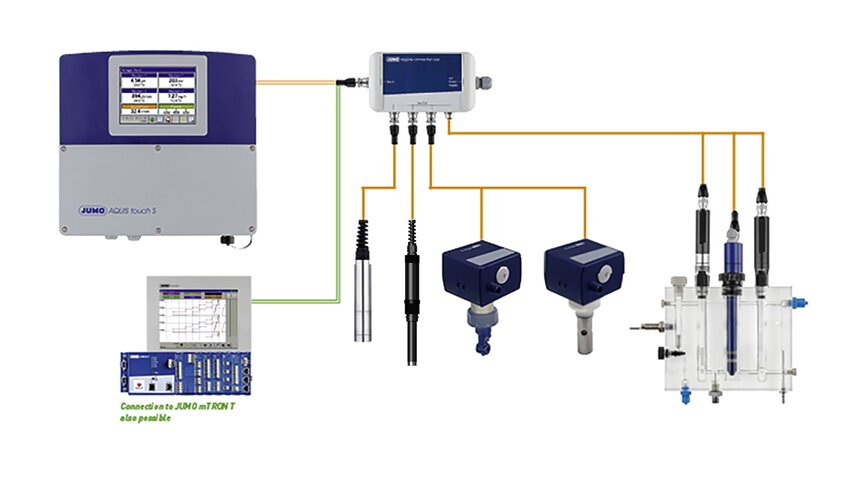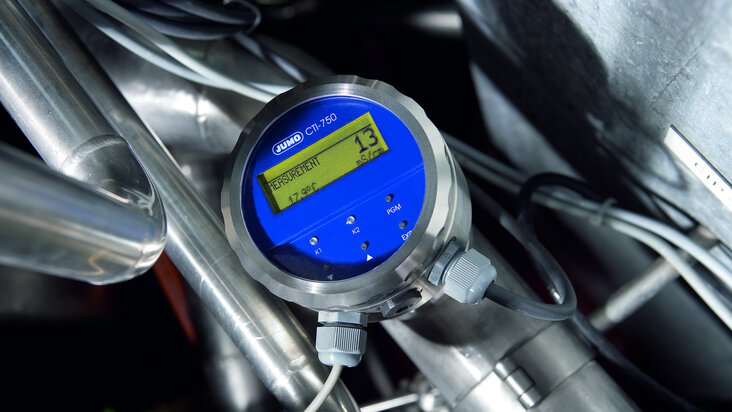

Electroplating baths – system for pH, temperature, conductivity and level control
By measuring conductivity, pH, level and temperature, it is possible to obtain more complete information about the etching, rinsing and greasing process in electroplating baths and to control and optimise it. However, the aggressive environment of electroplating baths requires specially adapted measurement sensors. Read on to find out how a company in the plating industry used a JUMO system!
Electroplating bath and electroplating process – what are they?
Electroplating baths are tanks made of stainless steel or plastic resistant to the corrosive products of electroplating. It is in them that metal is electroplated by coating it with thin layer of metal in a solution called a galvanic bath.
Depending on the type of metal ion produced, each metal plating process has corresponding name, like:
-
nickel plating,
-
chrome plating
-
zinc plating processes
-
gold plating
-
silver plating
-
copper plating
-
cadmium plating
Electroplating brings benefits such as Increased corrosion resistance, increased durability, improved electrical conductivity and decorative appeal.
Insert your Text here.
PH, conductivity and temperature measurements in electroplating baths
A plating bath operates within a strictly defined pH range. Because of this, pH is one of the most important parameters to be controlled in these solutions.
The consequences of suboptimal pH control can be catastrophic. For example, a pH that is too low in the weak-acid galvanising process has a destructive effect on the shiners, while in passivation it can cause discolouration to appear on the workpieces.
Other important parameters for electroplating baths are the closely related temperature and conductivity. The higher the temperature, the greater the conductivity of the solution and, consequently, the ability to deposit metal homogeneously even in low current areas.
Electroplating baths versus sensors for electroplating baths
Industrial bath – conductivity sensors
The JUMO CTI conductivity meter in PP/PFDV/PEEK design with an internal temperature sensor enables dedicated probe selection for a specific acid/base and direct measurement of conductivity in concentrated solutions, even at elevated temperatures.
Measurement values can be converted so that the transmitter outputs the concentration of the substance in question, provided that it is a single-component solution.
Integration of the system with an on-line industrial balance, after a period of empirical testing, allows the laboratory weighing method to be combined with conductivity measurement and an algorithm to be developed that minimises the influence of precipitating metal ions (e.g. copper or zinc) on the measurement of the concentration of a given acid.

Sulfuric acid electroplating bath and dedicated JUMO measuring system
PH, level and temperature probes in electroplating baths
The use of pH measurement on the water baths for rinsing and possible greasing after the etching process is used to monitor the amount of acid transferred between the baths and assess their suitability for further production.
If the limit value is reached, plant staff are informed of the need to add or replace water by means of a signal tower colour. The measuring system can also be supplemented with Teflon level probes to automate the water refilling system.
In addition, Pt100 temperature sensors in Teflon sheaths allow constant control of the optimum temperature on the baths, even in strongly acidic conditions.

JUMO measuring system for grease baths
Advantages of using digital pH electrodes
Possibility to network measurements
Connection of the central AQUIS touch transmitter to the 6 electrodes using only one cable, eliminating the need for individual cables for each electrode separately and effectively minimising instrument assembly time.
Measured as well as diagnostic values are transmitted to the transmitter via internal Modbus communication, more resistant to interference than typical analogue signals, especially over longer distances. The system informs the user of any electrode breakage and reminds them to calibrate.
Once the electrode itself has been unscrewed from the measuring system, calibration can be performed in the laboratory on a laptop running the DSM software, without having to go to the central measuring transmitter.
JUMO tecLINE HD pH electrodes
PH electrodes of the tecLINE HD type can operate in applications with temperatures up to 135°C and pressures up to 13 bar. Thanks to several variants made of different types of glass, they can be used in the full pH range from 0 to 14, as well as in the presence of fluoride in the sample. Using a dual pH measuring system with a large external diaphragm, it is also possible to measure directly in hydrofluoric acid.

Wszystkie pomiary pH i temperatury były wizualizowane na zewnętrznym komputerze i monitorze przemysłowym
- ${title}${badge}

